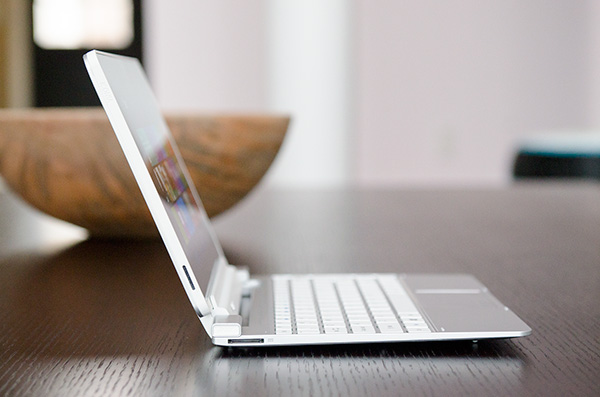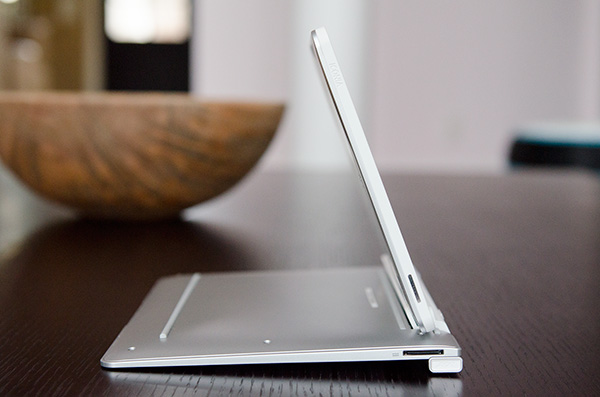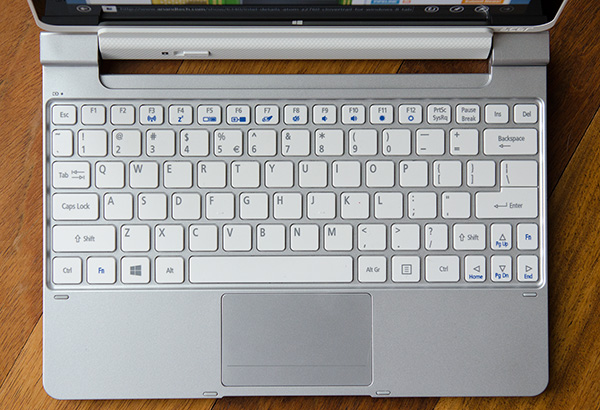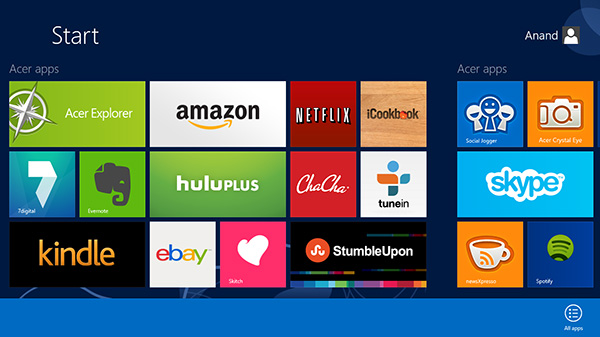The Clover Trail (Atom Z2760) Review: Acer's W510 Tested
by Anand Lal Shimpi on December 20, 2012 10:34 AM ESTThe Dock Experience
For $150 Acer will sell you a keyboard dock that gives you a full sized USB 2.0 port, a QWERTY keyboard, trackpad and integrated 27Wh battery. The dock charges the tablet, and the tablet powers the dock once the dock’s battery is exhausted. If this sounds familiar it’s because it’s exactly what ASUS has been offering since the first Eee Pad Transformer in 2011.
The tablet/dock mating process is actually one of the smoothest I’ve seen thus far. The tablet just slides in and locks in place - there’s no struggling or any real pain points in the process. Once connected the tablet seems pretty secure. As the dock uses the charging port to connect to the tablet (for both power and data), the dock gets its own charging port on the left side that you can use to power the setup.
The docking hinge can rotate up to 295 degrees, letting you face the W510 away from you with the keyboard pointing down. The keyboard is disabled once you hit opposite lock on the hinge, and what you end up with is an approximation of Surface’s mild-tilt-away operating mode. It’s good for presenting content to someone else or watching a video, but the angle is a bit too small to make it useful on a surface that’s significantly lower than you.
When assembled the tablet+dock loses the svelte form factor of the W510 itself. The combination grows to 13mm at its thinnest point and 23mm at its thickest. The weight more than doubles to 1265g (up from 568g for the tablet alone). The resulting device isn’t reminiscent of a tablet and instead reminds me a lot of a netbook. Ultimately where you fall on this issue depends on whether or not you want more of a tablet or notebook experience. The Surface approach retains the tablet experience while giving you some of the benefits of a standard clamshell notebook via the touch/type covers. The Acer/ASUS approach on the other hand gives you more of a flexible notebook experience, with the benefit of added battery life and IO expansion. As with most things, it’s a trade off.
Keyboard & Trackpad
In presenting Surface RT, Microsoft talked about the path that took it to building a fairly uncommon 10.6-inch tablet. The motivation behind the unique form factor was two fold: 1) Microsoft wanted to deliver a good multitasking experience under Windows 8’s Modern UI, and 2) it wanted to deliver a good typing experience with the touch/type cover attached. With a 10-inch tablet Microsoft felt the keyboard experience would suffer too much, but at 10.6-inches it could design a keyboard with big enough keys to approximate a good notebook keyboard.
There’s no better proof that Microsoft was right than to use the W510’s keyboard dock. While typing on Surface felt laptop-like from a size perspective, the W510’s dock feels more netbook-like. The alphanumeric keys measure around 13 x 14mm, compared to 16 x 16mm on Surface’s Touch Cover (71% coverage) and 17 x 17mm on Type Cover (63% coverage). That’s not to say that you can’t get used to it, it’s just immediately apparent that the keyboard is smaller than normal.
Key travel is pretty decent but the feel is mushier than I would like. Key placement is solid though, I didn’t have any trouble just jumping into the W510’s dock and finding my way around without staring at keys. Transitioning between the W510 and other physical keyboards wasn’t an issue either. I did occasionally have an issue where a key would repeat itself a bunch when typing (e.g. hellllllllllllllllllllllo instead of hello), but I'm not sure if that was a dock or Windows 8 problem.
What I couldn't get used to however is the trackpad. It’s almost 2013 and we’re still having issues delivering good PC trackpad experiences. The hardware, firmware and software to do this right is out in the wild and it’s not all that expensive, it just seems underutilized for whatever reason.
The W510’s trackpad is actually a clickpad, with no dedicated buttons but rather a horizontal line below which depressing the pad registers as a click. As with most clickpads, if you’re the type of user who rests a thumb near the “button” while you mouse around with your index finger you’re going to have a bad time. The W510 dock’s clickpad does a horrible job of rejecting any resting fingers/thumbs and instead you get very erratic, almost unusable tracking. Single finger operation is mostly ok, but even then there are issues. The clickpad seems to do a terrible job of rejecting noise in general. Sometimes just having a finger near the trackpad will be enough to throw off tracking.
Overall the clickpad is where the dock experience breaks down. The keyboard works well enough, but the clickpad is nothing short of frustrating. The good news is that you get a full USB 2.0 port from having the dock, so you can always plug in an external mouse, but that seems like a solution to a problem that shouldn’t have existed in the first place. I don’t know why we’re still dealing with clickpad issues, but I’m going to have to think up something creative to deter them in the future.
Software & Stability
The W510 ships with a full install of 32-bit Windows 8. As I mentioned earlier, there’s no free-Office with Windows 8 - that’s a Windows RT exclusive. On the plus side, you can still install traditional desktop mode applications which you can’t do on Windows RT.
Acer doesn’t do a whole lot to customize the Windows 8 experience, but there are a bunch preloaded apps that come on the system. The good news is that most of these apps aren’t things that run in the background at startup.
The bigger issue I had with the W510’s software experience had to do with stability. If I left the camera app running and the system went to sleep I’d frequently come back to a machine that had to reboot itself. Most of my stability issues seemed related to the camera app but every now and then apps would crash or I’d encounter an unexpected reboot. It’s clear to me that there are still a lot of rough edges with Windows 8, although interestingly enough I didn’t seem to have as many stability issues with Surface RT as far as I can remember.















104 Comments
View All Comments
strangis - Thursday, December 20, 2012 - link
"Which means nothing, as these mobile chips are too underpowered to actually run the desktop x86 applications"My ATIV 500 painting an 11x17 300dpi multilayer image in Sketchbook Pro with the active digitizer smoothly disagrees with your assumption.
Just saying.
Wolfpup - Thursday, January 3, 2013 - link
Of COURSE they run desktop programs. They run Firefox, OpenOffice (and older versions of MS Office you might already own), media tools, IM clients, all SORTS of things that aren't available or even possible on other platforms.No, it won't reasonably run Skyrim, but there's a ton that it will run.
Personally I think this is pretty awesome...you get a good for the form factor CPU that oh yeah, happens to actually be compatible with what you have, and the price is the same as ARM stuff.
What's bad is the GPU...seems like they have almost a 2009 smartphone GPU in there rather than something more appropriate for 2013...and then there's the issue that metro is locked down, not a real PC...but then that's why you want an x86 tablet to begin with...at least you get the real desktop and in that mode it's a real PC.
jeffkro - Thursday, December 20, 2012 - link
Basically for tablets and phones I prefer the android "library" so intel/windows really isn't for me anyways.SM123456 - Wednesday, February 13, 2013 - link
Yes, but Microsoft has to use a x86 CPU if they are to be able run Windows apps.Basically this device and all other Windows 8 tablets under $600 are grossly overpriced netbooks with touch added and a keyboard taken away.
The $199 Acer C7 Chromebook with its 1.1 GHz dual core Celeron processor is at least twice as fast as this thing.
Dribble - Thursday, December 20, 2012 - link
So we have windows RT that is optimised both around the ARM cpu's and tablets. There is no old software - everything that you can get for it should both run fine on tegra 3 and work well with a small touch screen. This means stuff should just work well - this is what apple do so well, and MS are trying to emulate.On the other hand there is full windows. Now the reason to get this not RT is backwards compatibility. Most *old* windows apps require higher performance cpu's (e.g core i3) a big screen, a mouse and a keyboard. They don't use touch at all.
Taking that into account an atom tablet has a screen that's too small, a cpu that's too slow and a bad mouse/keyboard experience - sure you could plug both in but then it's not really a tablet any longer is it? Also all that backward compatibility support uses effectively a different ui - it's not a clean and polished single interface. Stuff won't just work well - the experience won't be as good.
Hence if you want full windows you'd be much better off with a laptop/ultra book - they are still touch screen so you get any touch benefits but they have much faster cpu's, better keyboard, etc.
Shadowmaster625 - Thursday, December 20, 2012 - link
Not sure where you got that idea from. 99% of windows applications dont hardly use any cpu at all. Check task manager sometime. You will notice that most processes only consume a few seconds of cpu time per hour of system idle time. It is extremely rare for a windows application to peg even one cpu core to 100%.freedom4556 - Thursday, December 20, 2012 - link
You that that's a percentage and it depends on what CPU you're looking at right? That's like saying, "Yeah, I never need more than 1% of my horsepower even doing 150mph uphill in a headwind." when you drive a Lamborghini. Try it again in a Honda and you'll not even be able to do it, nevermind 100% usage.Do you have an i7 or an Atom?
B3an - Thursday, December 20, 2012 - link
One thing that stood out to me in this article, is the bugs/reboots you encountered. You pretty much blamed them on Win 8, or made it sound that way. Which i thought was unprofessional, especially for you Anand. As theres a very good chance they're to do with a particular app, drivers on this device, or even it's hardware. Win 8 is a very solid stable OS, even more so than Win 7 on release.ltcommanderdata - Thursday, December 20, 2012 - link
True. But hasn't it always been the case that app and driver instability gets fairly or unfairly associated with Windows? At the same time, when things are working well, Microsoft is happy if you think of yourself as enjoying a "Windows" PC or tablet regardless of what particular software or hardware you are using in/on Windows. I guess we'll have to see how common problems are with other CloverTrail tablets. If they show up in CloverTrail tablets from other manufacturers, then even if the underlying OS is stable it still becomes Microsoft's problem if people are having trouble developing reliable apps/drivers/tablet using it.Anand Lal Shimpi - Thursday, December 20, 2012 - link
The issue is these were first party apps developed by MS, and I've seen some evidence of the same on other non-W510 platforms (I just don't remember this being the case with Surface RT but I've been using these x86 platforms longer than I did Surface).I'm curious to read Vivek's take on the ATIV Smart PC to see if it mirrors my experience.
Take care,
Anand